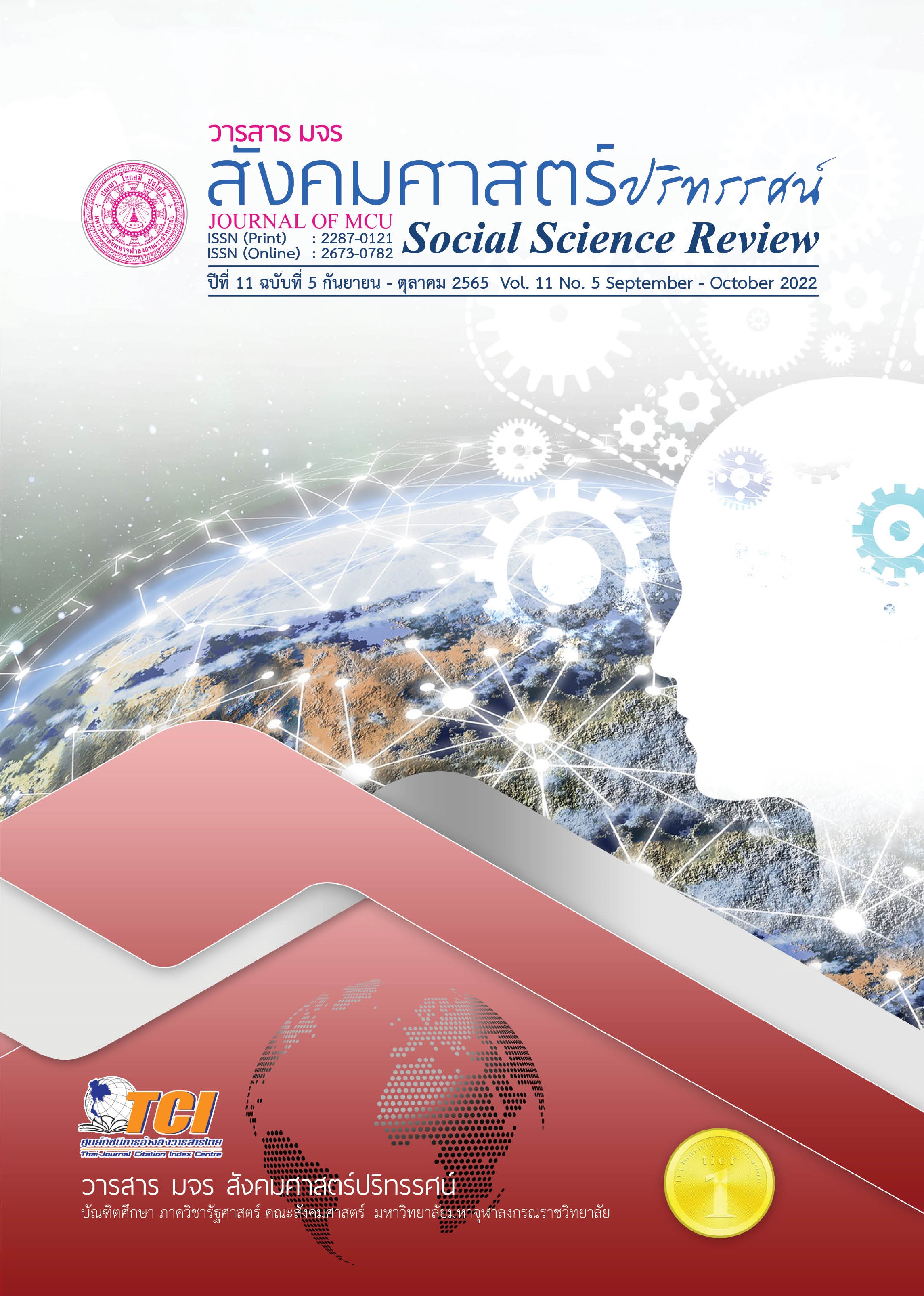การวิเคราะห์โมเดลประสบการณ์การท่องเที่ยวที่น่าจดจำและคุณลักษณะของแหล่งท่องเที่ยวที่ส่งผลต่อการกลับมาเที่ยวซ้ำ
คำสำคัญ:
คุณลักษณะของจุดหมายปลายทางการท่องเที่ยว, ประสบการณ์การท่องเที่ยวที่น่าจดจำ, ความตั้งใจกลับมาเที่ยวซ้ำบทคัดย่อ
การศึกษาครั้งนี้มีวัตถุประสงค์เพื่อศึกษาคุณค่าประสบการณ์การท่องเที่ยวที่น่าจดจำของแหล่งท่องเที่ยว และวิเคราะห์รูปแบบความเชื่อมโยงของประสบการณ์การท่องเที่ยวที่น่าจดจำ คุณลักษณะของจุดหมายปลายทางการท่องเที่ยวต่อความตั้งใจกลับมาเที่ยวซ้ำในกลุ่มจังหวัดภาคเหนือตอนล่าง 1 เป็นการวิจัยเชิงปริมาณโดยใช้แบบสอบถามความคิดเห็นนักท่องเที่ยวชาวไทยที่ท่องเที่ยวในกลุ่มจังหวัดภาคเหนือตอนล่าง 1 จำนวน 400 คน วิเคราะห์ข้อมูลโดยการวิเคราะห์องค์ประกอบเชิงยืนยันและแบบจำลองสมการโครงสร้าง (Structural Equation Modelling)
ผลการศึกษาพบว่า ยอมรับสมมติฐานการวิจัยทั้ง 3 ข้อ โดยคุณลักษณะของจุดหมายปลายทางการท่องเที่ยวมีอิทธิพลต่อประสบการณ์การท่องเที่ยวที่น่าจดจำอย่างมีนัยสำคัญทางสถิติที่ระดับ .01 ประสบการณ์การท่องเที่ยวที่น่าจดจำมีอิทธิพลต่อความตั้งใจกลับมาเที่ยวซ้ำอย่างมีนัยสำคัญทางสถิติที่ระดับ .01 และคุณลักษณะของจุดหมายปลายทางการท่องเที่ยวมีอิทธิพลต่อความตั้งใจกลับมาเที่ยวซ้ำอย่างมีนัยสำคัญทางสถิติที่ระดับ .05
เอกสารอ้างอิง
ณัฏฐ์พัชร์ กาญจนรัตน์ และกุลพิชญ์ โภไคยอุดม. (2563). องค์ประกอบทางการท่องเที่ยวที่ส่งผลต่อความสนใจท่องเที่ยวเชิงโหยหาอดีตของนักท่องเที่ยวชาวไทยที่อาศัยอยู่ในกรุงเทพมหานคร. วารสารวิทยาศาสตร์การกีฬาและสุขภาพ, 21(2), 283-294.
พฤทธ์สรรค์ สุทธิไชยเมธี. (2563). สถิติขั้นสูงเพื่อการวิจัยเชิงปริมาณทางสังคมศาสตร์. กรุงเทพ: สำนักพิมพ์ซีเอ็ดยูเคชั่น, บมจ.
อริยา พงษ์พานิช. (2560). ปัจจัยดึงดูดที่ส่งผลให้นักท่องเที่ยวเดินทางมาเที่ยวเกาะล้าน เขตเมืองพัทยา จังหวัดชลบุรี. อุบลราชธานี: มหาวิทยาลัยอุบลราชธานี.
อัจฉรา หล่อตระกูล. (2562). การวิเคราะห์ปัจจัยที่มีอิทธิพลต่อการท่องเที่ยวของนักท่องเที่ยวชาวไทย กรณีศึกษา : พระราชวังบางปะอิน จังหวัดพระนครศรีอยุธยา. วารสาร มจร สังคมศาสตร์ปริทรรศน์, 8(3), 178-188.
Azis S, et al. (2018). Creating an innocuous mangrove ecosystem: Understanding the influence of ecotourism products from Malaysian and international perspectives. Ocean & Coastal Management, 165(November), 416-427.
Bailey, K. (2007). Methods of social research (4th ed.). New York: Free Press.
Chandralal, L., & Valenzuela, F.-R. (2015). Memorable tourism experiences: Scale development. Contemporary Management Research, 11(3), 291-310.
Chekalina, T., et al. (2018). Customer-based destination brand equity modeling: The role of destination resources, value for money, and value in use. Journal of Travel Research, 57(1), 31-51.
Chen, X, et al. (2020). Make it memorable: Tourism experience, fun, recommendation and revisit Intentions of Chinese outbound tourists. Sustainability, 12, 1-24.
Frankfort-Nachmias, C., et al. (2015). Research methods in the social sciences (8 ed.). New York: Worth Publishers.
Kiatkawsin, K., & Han, H. (2017). An alternative interpretation of attitude and extension of the value-attitude-behavior hierarchy: The destination attributes of Chiang Mai, Thailand. Asia Pacific Journal of Tourism Research, 22, 481-500.
Kim, J.-H. (2014). The antecedents of memorable tourism experiences: The development of a scale to measure the destination attributes associated with memorable experiences. Tourism Management, 44, 34–45.
_____. (2018). The impact of memorable tourism experiences on loyalty behaviors: The mediating effects of destination image and satisfaction. Journal of Travel Research, 57(7), 856–870.
Kline, R. B. (1998). Principles and practice of structural equation modeling. NY: The Guilford Press.
Kotler, P. (2015). Marketing Management (15 ed.). USA: Pearson Education.
Lee, Y. H., & Ang, K. S. (2003). Brand name suggestiveness: a Chinese language perspective. International Journal of Research in Marketing, 20(4), 323-335.
Mahdzar, M. (2019). Tourists' perception on memorable tourism experience towards their revisit intentions to Islamic tourism destination in Shah Alam, Selangor. Journal of Emerging Economies & Islamic Research, 7(1), 37-44.
Mahdzar, M., et al. (2015). The role of destination attributes and memorable tourism experience in understanding tourist revisit intentions. American-Eurasian Journal of Agriculture & Environmental Science, 15(1), 32-39.
Şahin, İ., & Güzel, F. Ö. (2020). Do experiential destination attributes create emotional arousal and memory?: A comparative research approach. Journal of Hospitality Marketing & Management, 29(8), 956-986.
Singh, R., & Singh, J. (2019). Destination attributes to measure tourist revisit intention: A scale development. Global Business Review, 20(2), 549–572.
Sthapit, E., & Coudounaris, D. N. (2017). Memorable tourism experiences: antecedents and outcomes. Scandinavian Journal of Hospitality and Tourism, 18(1), 72-94.
Verinita, V., & Yola, F. (2020). Analysis of the model of memorable tourist experience, destination image, and tourist value on the revisit intention. In R. Hurriyati, B. Tjahjono, I. Yamamoto, A. Rahayu, A. G. Abdullah, & A. A. Danuwijaya (Eds.), Advances in business, management and entrepreneurship (pp. 183-187). London: CRC Press.
Weston, R., & Gore, P. A., Jr. (2006). A brief guide to structural equation modeling. The Counseling Psychologist, 34(5), 719–751.
Widjaja, Y. I., & Khalifa, G. S. A. (2019). The effect of destination reputation on the revisit intention to halal tourism destination of Jakarta International Journal of Business, Economics and Law, 20(5), 104-111.
Yachin, J. M. (2018). The‘customer journey’: Learning from customers in tourism experience encounters. Tourism Management Perspectives, 28, 201-210.
Zhang, H., Wu, Y., & Buhalis, D. (2018). A model of perceived image, memorable tourism experiences and revisit intention. Journal of Destination Marketing & Management, 8, 326–336.
ดาวน์โหลด
เผยแพร่แล้ว
รูปแบบการอ้างอิง
ฉบับ
ประเภทบทความ
สัญญาอนุญาต
ลิขสิทธิ์ (c) 2022 วารสาร มจร สังคมศาสตร์ปริทรรศน์

อนุญาตภายใต้เงื่อนไข Creative Commons Attribution-NonCommercial-NoDerivatives 4.0 International License.
เพื่อให้เป็นไปตามกฎหมายลิขสิทธิ์ ผู้นิพนธ์ทุกท่านต้องลงลายมือชื่อในแบบฟอร์มใบมอบลิขสิทธิ์บทความให้แก่วารสารฯ พร้อมกับบทความต้นฉบับที่ได้แก้ไขครั้งสุดท้าย นอกจากนี้ ผู้นิพนธ์ทุกท่านต้องยืนยันว่าบทความต้นฉบับที่ส่งมาตีพิมพ์นั้น ได้ส่งมาตีพิมพ์เฉพาะในวารสาร มจร สังคมศาสตร์ปริทรรศน์ เพียงแห่งเดียวเท่านั้น หากมีการใช้ภาพหรือตารางหรือเนื้อหาอื่นๆ ของผู้นิพนธ์อื่นที่ปรากฏในสิ่งตีพิมพ์อื่นมาแล้ว ผู้นิพนธ์ต้องขออนุญาตเจ้าของลิขสิทธิ์ก่อน พร้อมทั้งแสดงหนังสือที่ได้รับการยินยอมต่อบรรณาธิการ ก่อนที่บทความจะได้รับการตีพิมพ์ หากไม่เป็นไปตามข้อกำหนดเบื้องต้น ทางวารสารจะถอดบทความของท่านออกโดยไม่มีข้อยกเว้นใดๆ ทั้งสิ้น





